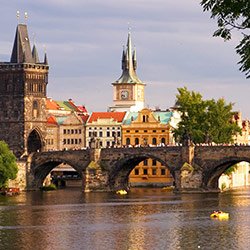Control Engineering II
Engineering & Social Sciences Program
Madrid, Spain
Dates: 1/19/23 - 6/3/23

Control Engineering II
OVERVIEW
CEA CAPA Partner Institution: Universidad Carlos III de Madrid
Location: Madrid, Spain
Primary Subject Area: Electrical Engineering
Instruction in: English
Course Code: 14032
Transcript Source: Partner Institution
Course Details: Level 300
Recommended Semester Credits: 3
Contact Hours: 42
Prerequisites: Control Engineering I
DESCRIPTION
The programme is composed of the following parts:
First Part:
1. Z Transform.
1.1 Modelling of a discrete-time system.
1.2 Differences equations.
1.3 Z Transform, inverse and properties.
1.4 Differences equation solution.
2. Obtaining the Transfer Function.
2.1 Hold and Sampler.
2.2 Obtaining the transfer function in the z domain.
2.3 Sampling theorem.
3. Stability analysis.
3.1 Stability analysis in the z plane.
3.2 Jury stability test.
3.3 Root locus in the z plane.
3.4 Analysis of the system response.
4. Discretization of continuous systems.
4.1 Discretization of a continuous system.
4.2 Equivalent discrete transfer function.
4.3 Sampling a transfer function.
4.4 Discretization of an analogic controller.
5. Design of PID Controllers.
5.1 PID controllers in discrete time.
5.2 Discretization of an analogic PID controller.
5.3 Obtaining the sampling time.
5.4 Design of PID controllers by the root locus method
6. Design of controllers by direct synthesis.
6.1 Design of controllers by direct synthesis.
6.2 Restrictions: physically possible and stability.
6.3 Simplicity.
Second Part:
7. Modelling and analysis of systems in the state space.
7.1 Introduction to the state space.
7.2 Linearization.
7.3 Representations in the state space.
7.4 Equivalences between systems.
7.5 Obtaining the state space model.
7.6 Transformations between representation.
7.7 Obtaining the transfer function from the state space model.
8. Solution of the state space equation.
8.1 Transition matrix. Properties.
8.2 Solution of the state space equation in continuous time.
8.3 Discretization.
8.4 Solution of the state space equation in discrete time.
9. State Feedback Control.
9.1 Controllability and observability.
9.2 State feedback control: positioning poles.
9.3 Gain adjustment.
9.4 Modification of the type of a system.
10. Design of Observers.
10.1 Full-order state observer.
10.2 Dynamics of the combined system with a full-order observer and a state feedback matrix.
10.3 Minimum-order observer.
First Part:
1. Z Transform.
1.1 Modelling of a discrete-time system.
1.2 Differences equations.
1.3 Z Transform, inverse and properties.
1.4 Differences equation solution.
2. Obtaining the Transfer Function.
2.1 Hold and Sampler.
2.2 Obtaining the transfer function in the z domain.
2.3 Sampling theorem.
3. Stability analysis.
3.1 Stability analysis in the z plane.
3.2 Jury stability test.
3.3 Root locus in the z plane.
3.4 Analysis of the system response.
4. Discretization of continuous systems.
4.1 Discretization of a continuous system.
4.2 Equivalent discrete transfer function.
4.3 Sampling a transfer function.
4.4 Discretization of an analogic controller.
5. Design of PID Controllers.
5.1 PID controllers in discrete time.
5.2 Discretization of an analogic PID controller.
5.3 Obtaining the sampling time.
5.4 Design of PID controllers by the root locus method
6. Design of controllers by direct synthesis.
6.1 Design of controllers by direct synthesis.
6.2 Restrictions: physically possible and stability.
6.3 Simplicity.
Second Part:
7. Modelling and analysis of systems in the state space.
7.1 Introduction to the state space.
7.2 Linearization.
7.3 Representations in the state space.
7.4 Equivalences between systems.
7.5 Obtaining the state space model.
7.6 Transformations between representation.
7.7 Obtaining the transfer function from the state space model.
8. Solution of the state space equation.
8.1 Transition matrix. Properties.
8.2 Solution of the state space equation in continuous time.
8.3 Discretization.
8.4 Solution of the state space equation in discrete time.
9. State Feedback Control.
9.1 Controllability and observability.
9.2 State feedback control: positioning poles.
9.3 Gain adjustment.
9.4 Modification of the type of a system.
10. Design of Observers.
10.1 Full-order state observer.
10.2 Dynamics of the combined system with a full-order observer and a state feedback matrix.
10.3 Minimum-order observer.








